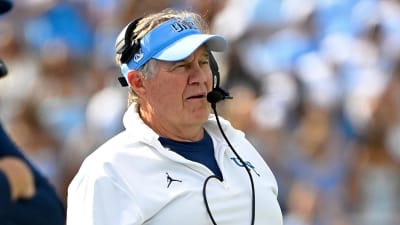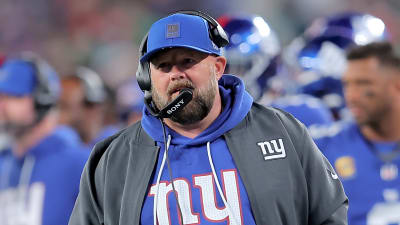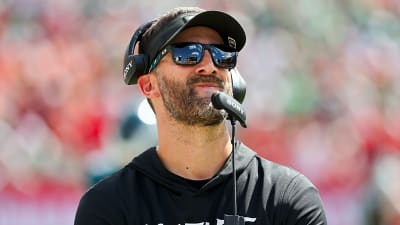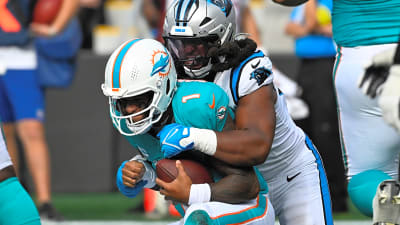
The “Philadelphia Eagles Tush Push,” officially known as the “Brotherly Shove,” has once again placed itself at the epicenter of controversy within the National Football League, reigniting the contentious debate over its legality and long-term place in the sport.
The latest spark came during a Thursday Night Football contest where the Philadelphia Eagles, the undisputed masters of the short-yardage maneuver, executed a breathtaking—or infuriating, depending on one’s allegiance—series of plays.
Deep inside the red zone against the New York Giants, the Eagles ran the quarterback sneak with aid from their linemen and pushers four consecutive times. This aggressive, unprecedented sequence consumed two crucial minutes of game clock and culminated in an unstoppable Jalen Hurts touchdown, tipping the score in favor of the reigning Super Bowl contenders, 17-13. However, they lost the game 34-17.
Tush Push (x4) pic.twitter.com/v1NdzvZJdM
— Philadelphia Eagles (@Eagles) October 10, 2025
The sheer audacity and clinical efficiency of using the same low-risk, high-reward play four times in a row has elevated the discussion from a technical rule interpretation to a fundamental question of what constitutes “football.”
While the play remains fully legal under current NFL rules, its deployment—particularly the repeated, concentrated application by Philadelphia—is viewed by many across the league as an unfair exploit that fundamentally breaks the competitive balance of goal-line defense.
The Eagles are leveraging a perfect storm of a powerful offensive line, an exceptional rugby-style ruck formation, and a robust quarterback, making the ‘Brotherly Shove’ nearly indefensible.
This recent spectacle against the Giants, where success was guaranteed through sheer force, is forcing the NFL to confront the reality that the play is not just an advantage, but a virtual cheat code for short yardage.
Mounting Criticism and Player Safety Concerns
The reaction across social media and within the professional football community was immediate and overwhelmingly negative. Viewers expressed frustration, labeling the tactic as “boring” and detrimental to the entertainment value of the game.
Perhaps the most prominent critique came from Green Bay Packers defensive stalwart Micah Parsons, who publicly declared, “This ain’t football,” accompanying his post with pointed “trash can” emojis, articulating the sentiment that the play diminishes the athleticism and strategic complexity traditionally associated with goal-line stands.
This is not football!
— Micah Parsons (@MicahhParsons11) October 10, 2025
However, the consequences of the four-play sequence extended far beyond mere aesthetic complaints; they underscored the critical player safety issue. During the final, successful push, Giants defensive tackle D.J. Davidson sustained a knee injury. Davidson had to be carted off the field and was immediately declared questionable to return.
This type of low-body, high-impact injury risk has been the primary argument against the Tush Push, suggesting that the concentrated force of a multi-player scrum creates an inherently dangerous environment. The Giants, who had previously voted in favor of banning the play during the offseason, felt the tangible cost of the maneuver firsthand.
This is not a new concern. The Green Bay Packers initially proposed the ban, citing injury fears as their chief motivation. Despite the widespread agreement on safety—highlighted by 22 of 32 teams voting to outlaw it—the measure fell just two votes shy of the two-thirds majority required for approval.
The highly visible injury to Davidson immediately serves as powerful, visual evidence that will fuel the safety argument when the owners reconvene to discuss rule changes next season.
The Questionable Enforcement of Rules
Another critical element adding fuel to the fire is the perennial issue of officiating and rule enforcement, specifically concerning potential false start penalties. Critics argue that the success of the Tush Push often hinges on an imperceptible timing advantage that may involve linemen moving prior to the snap.
This complaint was magnified earlier in the season during the highly anticipated Super Bowl rematch between the Eagles and the Kansas City Chiefs. On that Sunday night, which drew a record-breaking 33.8 million viewers, the Eagles executed seven Tush Pushes, appearing to benefit from multiple potential false starts that went uncalled.
The lack of consistent enforcement has drawn the ire of some of the league’s most respected figures. Chiefs Head Coach Andy Reid commented on the matter, stating, “If the guys are moving early, then you have to judge it… I felt like guys were moving. That’s why I was complaining about it on the sideline to the officials.”
Reid’s comments highlight a key problem: the ambiguity in judging the precise moment of the snap and the coordination of the pushers. If the league cannot consistently and fairly officiate the play—either by being too lenient or by having a rule too difficult to police—it further strengthens the case for outright prohibition. The confluence of safety risks and ambiguous officiating suggests that the play is fundamentally unsuited for the NFL rulebook.
Losing Faith: The Play’s Inevitable Demise
Perhaps the most telling sign of the play’s doomed future is the diminishing confidence of those who perfected it. Jason Kelce, the former Eagles All-Pro center and one of the integral architects of the Philadelphia Eagles ‘Tush Push’ phenomenon, has publicly stated his belief that the play is on its way out. Speaking on Sportsradio 94WIP in Philadelphia, Kelce admitted, “I think the play is done.”
WOW: Jason Kelce believes the Tush Push is done after the season.
"I think the play is done…I think that enough people want it gone and enough people in important places want it gone." pic.twitter.com/0QpO5Bwhh3
— SPORTSRADIO 94WIP (@SportsRadioWIP) September 18, 2025
Kelce’s pragmatism stems from his deep understanding of the league’s political landscape. He believes that the pressure from various levels of the NFL—coaches, owners, and competition committees—is too great to ignore.
His resignation is perhaps the most powerful testimony against the play, as it comes from a player who leveraged it to unprecedented success. Kelce’s take suggests that the Eagles’ continued, aggressive use of the play is a strategy to maximize its value while it is still legal, essentially running up the score on the rulebook before it gets amended.
While he is confident the Eagles can still find success in short-yardage situations without it, his admission serves as an internal confirmation that the controversy has reached a tipping point, making a ban less a matter of “if” and more a matter of “when.”
Conclusion: A Looming Ban
The four-consecutive ‘Tush Pushes’ against the Giants did more than just win a game; they pushed the NFL rulebook to its breaking point. This latest episode has consolidated all the arguments against the play: it’s aesthetically unpleasing, it poses a demonstrable injury risk (as seen with D.J. Davidson), and its execution relies on questionable officiating.
With key figures, including the play’s own champions, acknowledging its inevitable demise, the stage is set for a dramatic showdown in the next offseason. The required two-thirds vote to ban the play in the next round of owners’ meetings seems all but assured, ending the tenure of the ‘Brotherly Shove’ as the NFL’s most dominant—and most reviled—short-yardage weapon.
More must-reads:
- NFL Draft intel: Five prospects on the rise — including Alabama’s Ty Simpson
- Bijan Robinson's record-breaking pace should make him early OPOY favorite over fellow star RB
- The 'NFL total touchdown pass leaders' quiz
Breaking News
Trending News
Customize Your Newsletter
 +
+
Get the latest news and rumors, customized to your favorite sports and teams. Emailed daily. Always free!









